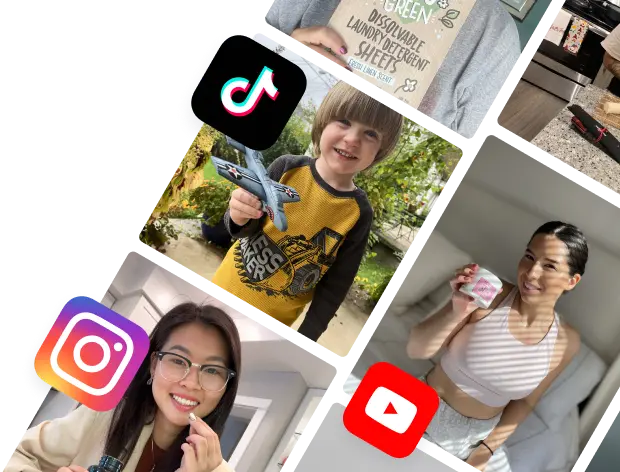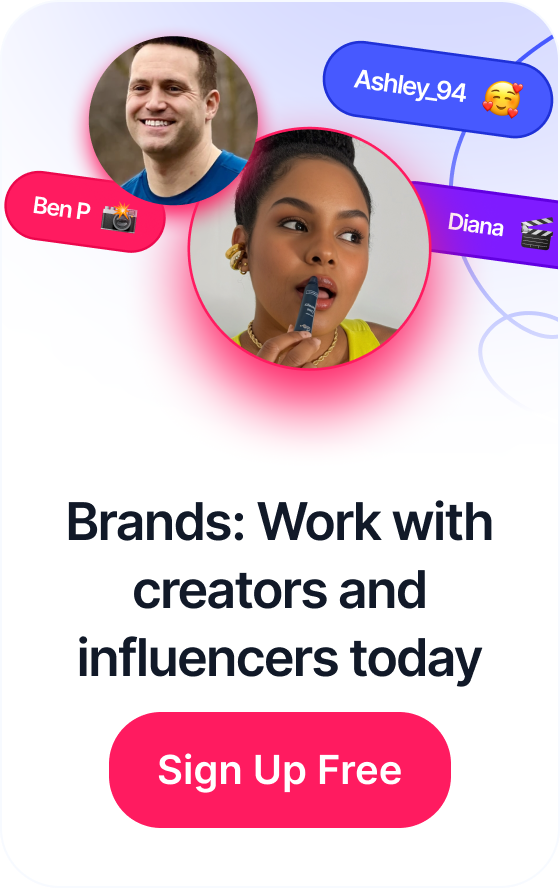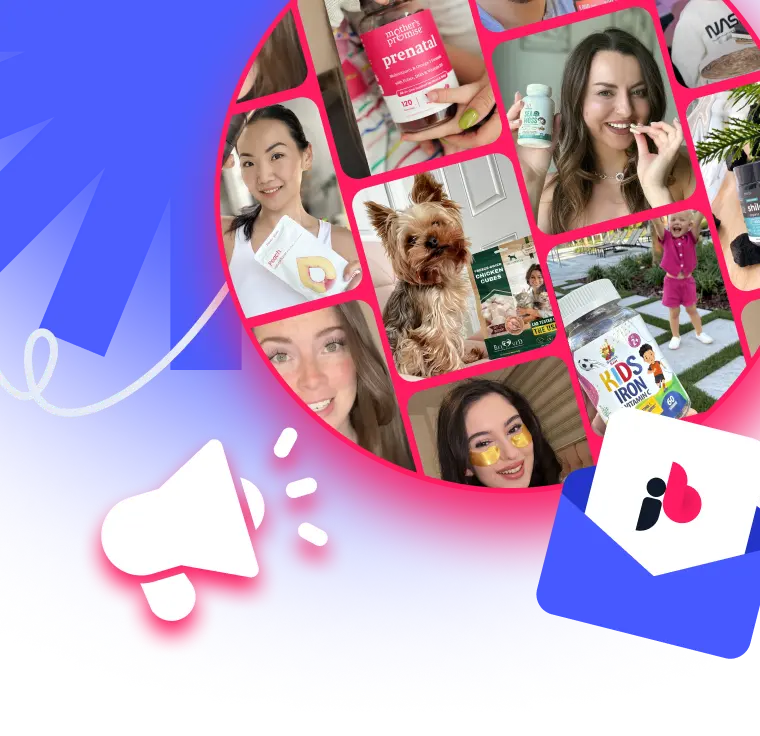 10 Game-Changing IG Reels Ideas for 2025
10 Game-Changing IG Reels Ideas for 2025
In a world saturated with brand messages, authenticity cuts through the noise. Modern consumers trust peers far more than polished ads, making user-generated content (UGC) a cornerstone of effective marketing. It's the unfiltered reviews, viral TikTok challenges, and genuine unboxing videos that build real connections and drive purchasing decisions. This is not just content; it's social proof in its most powerful form.
This article moves beyond basic descriptions to provide a deep strategic analysis of powerful user generated content examples. We will break down what makes successful campaigns work, from Instagram hashtag contests to video testimonials and customer-led community forums. For each example, you will find replicable tactics and actionable takeaways designed to be implemented immediately, especially for brands leveraging creator platforms to scale their efforts.
By understanding the 'how' and 'why' behind these proven strategies, you can empower your brand to harness the voice of your customers. The goal is to transform passive buyers into active advocates and co-creators of your brand's narrative. Get ready to unlock the specific methods that turn authentic customer content into measurable growth and a competitive advantage.
Table of Contents
1. Instagram Hashtag Campaigns
Instagram hashtag campaigns are a classic and powerful method for collecting high-quality user-generated content. This strategy involves creating a unique, branded hashtag and encouraging your audience to use it when they post photos or videos featuring your products or brand. The result is a dynamic, searchable gallery of authentic content that acts as powerful social proof, builds community, and provides a steady stream of marketing assets. These campaigns transform passive followers into active brand advocates.
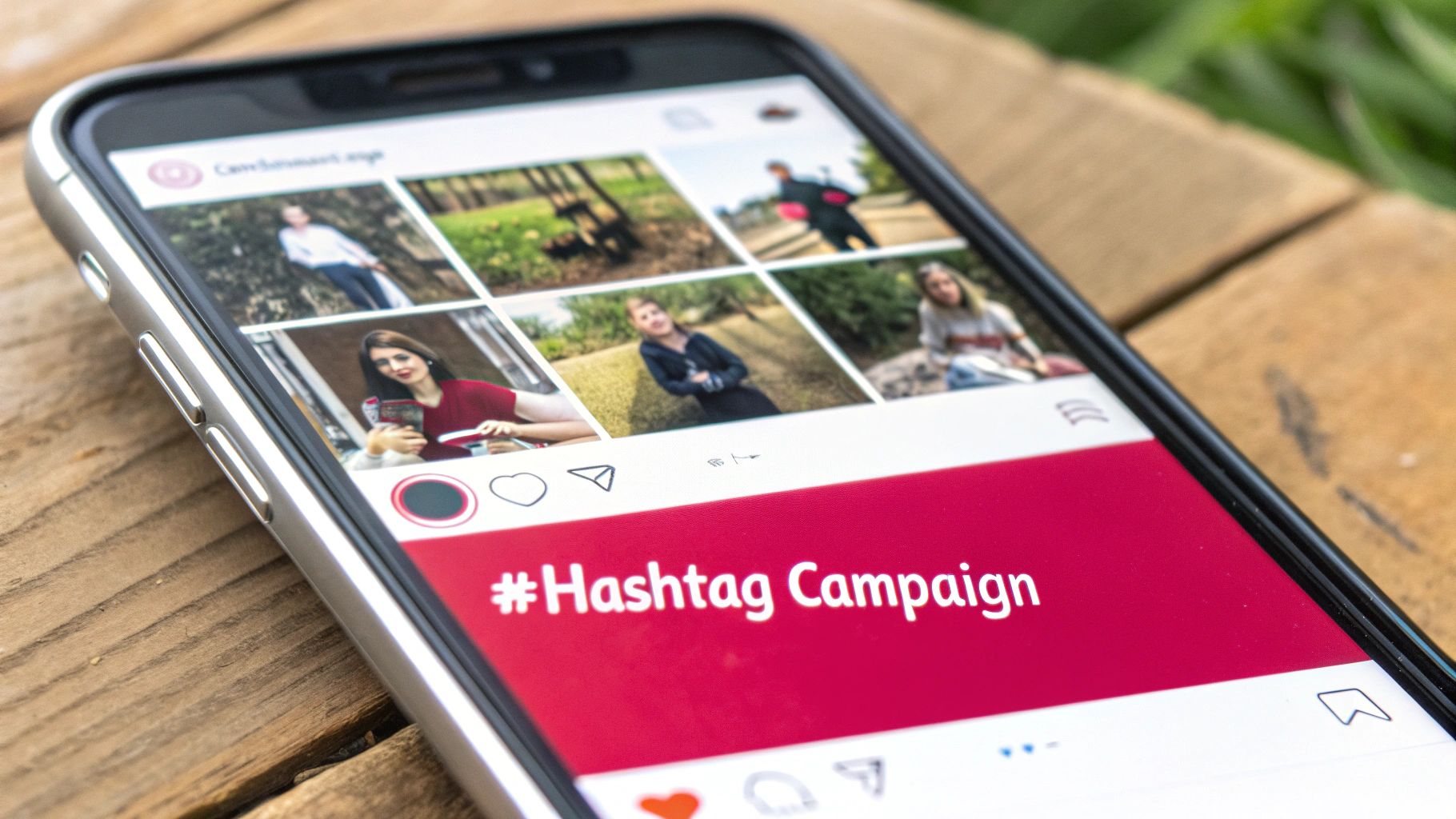
One of the most famous user-generated content examples is Coca-Cola's #ShareACoke campaign. By personalizing bottles with names and encouraging people to find and share photos with their own or a friend's name, Coca-Cola tapped into a universal desire for connection and recognition. This simple yet brilliant concept generated millions of posts, turning a physical product into a viral social media moment.
Strategic Breakdown
- Emotional Connection: The campaign wasn't just about the drink; it was about sharing a moment with someone. This emotional hook is what made the UGC so compelling and widespread.
- Simplicity and Accessibility: The call to action was incredibly simple: find a bottle, take a picture, and share it. There were no complex rules, making participation easy for everyone.
- Built-in Virality: The act of "sharing a Coke" with someone often involved tagging them, which naturally amplified the campaign's reach and brought new people into the conversation.
Key Insight: The most successful hashtag campaigns give users a specific, personal, and shareable reason to create content. It’s less about the brand and more about the user’s experience and identity.
Actionable Takeaways for Your Brand
- Make it Personal: Brainstorm hashtags that allow users to express their own identity or story, like #My[Brand]Story or #[Brand]InTheWild.
- Incentivize Participation: Run a contest, like Starbucks' annual #RedCupContest, where the best photos win a prize or are featured on your official account. This gamification significantly boosts submissions.
- Engage and Amplify: Actively monitor your hashtag. Like, comment on, and reshare the best submissions (always asking for permission first). This engagement validates participants and encourages more people to join in.
2. Customer Review and Rating Systems
Customer review and rating systems are a foundational form of user-generated content, allowing customers to directly share their experiences with products or services. These systems, which include star ratings, detailed written feedback, and even photo or video uploads, serve as a critical trust signal for new buyers. They create a transparent feedback loop, providing social proof that directly influences purchasing decisions and offering invaluable insights for business improvement.

Amazon pioneered and perfected this model, turning customer reviews into an indispensable part of the e-commerce experience. By integrating features like "Verified Purchase" tags, helpfulness votes, and customer-submitted photos, Amazon built a robust ecosystem of user-generated content that consumers rely on daily. This system doesn't just sell products; it builds a community of informed buyers and holds sellers accountable for quality.
Strategic Breakdown
- Trust and Authenticity: Reviews from real buyers are perceived as more authentic and trustworthy than traditional advertising. The "Verified Purchase" label is a simple but powerful mechanism that validates the reviewer's experience.
- Information Richness: Star ratings offer a quick snapshot, while detailed written reviews provide the specific "why" behind the score. This combination addresses the needs of different types of shoppers, from quick scanners to in-depth researchers.
- Search Engine Optimization: Customer reviews are rich with long-tail keywords related to the product's use, features, and benefits. This user-generated content constantly refreshes product pages, boosting their relevance and ranking in search results.
Key Insight: A strong review system transforms the customer from a passive consumer into an active contributor to your brand's reputation and visibility. It outsources trust-building to your happiest customers.
Actionable Takeaways for Your Brand
- Automate the Ask: Use post-purchase email or SMS sequences to automatically request a review after a customer has had enough time to experience the product. Make the request polite, direct, and easy to fulfill.
- Respond to Everything: Publicly and professionally respond to both positive and negative reviews. Thanking positive reviewers reinforces their loyalty, while addressing negative feedback shows you care and can even turn a bad experience around.
- Leverage Reviews as Marketing Assets: Showcase your best reviews on your homepage, product pages, social media posts, and in email campaigns. Quote compelling snippets to create powerful, authentic marketing copy.
3. Video Testimonials and Unboxing Content
Video testimonials and unboxing experiences are incredibly potent forms of user-generated content, moving beyond static images to offer dynamic, authentic narratives. This strategy involves encouraging customers to film their genuine reactions, first impressions, and long-term results with a product. From the excitement of an unboxing to a detailed tutorial, these videos provide compelling social proof, build trust through transparency, and create a powerful emotional connection with prospective buyers.
Brands like Glossier have masterfully leveraged this type of UGC. Instead of relying solely on professional models, Glossier showcases real customers using their products in "Get Ready With Me" (GRWM) style videos. These authentic skincare and makeup routines, shared across social media, demonstrate product efficacy in a relatable, real-world context. This approach turns everyday users into influential brand storytellers, showing exactly how the products fit into a person's life.
Strategic Breakdown
- Authenticity and Trust: Watching a real person unbox and use a product is far more convincing than a polished advertisement. It removes the skepticism associated with traditional marketing.
- Visual Demonstration: Videos effectively show a product's features, size, quality, and use case in a way that static photos cannot. This is especially crucial for beauty, tech, and fitness products.
- Emotional Resonance: The genuine excitement of an unboxing or the pride in a transformation video creates an emotional impact that resonates deeply with viewers and builds a stronger brand-to-consumer bond.
Key Insight: Video UGC thrives on creating a vicarious experience. When a potential customer watches someone else's genuine delight or success, they begin to emotionally invest in that outcome for themselves.
Actionable Takeaways for Your Brand
- Simplify the Submission Process: Create a clear, easy-to-use portal or a dedicated hashtag for video submissions. The fewer steps required, the higher the participation rate.
- Provide Clear Guidelines: Offer simple prompts or questions for customers to answer in their testimonials (e.g., "What problem did our product solve for you?"). For unboxings, suggest they capture the packaging and their first impression.
- Incentivize High-Quality Content: Reward the best video submissions with gift cards, free products, or a prominent feature on your website and social channels. This encourages users to put more effort into their filming.
4. Social Media Photo Contests
Social media photo contests are structured competitions that incentivize users to create and submit high-quality visual content. Brands set a specific theme, often related to their products or values, and offer compelling prizes in exchange for participation. This strategy gamifies content creation, turning it into a competitive event that generates a high volume of authentic visuals, boosts engagement, and expands brand reach through participants' networks.

A standout example comes from outdoor apparel brand Patagonia. Their photo contests frequently challenge followers to submit their best shots of adventures in the wild, often with a conservationist angle. By tapping into their community's shared passion for nature and exploration, Patagonia receives stunning, professional-quality images that perfectly align with their brand ethos. This collection of user-generated content examples reinforces their image as an authentic, community-driven company.
Strategic Breakdown
- Value Alignment: Patagonia’s contest themes are not just about their products; they are about the lifestyle and values their customers cherish. This alignment produces content that feels genuine, not promotional.
- Aspirational Motivation: The prizes are often desirable gear or unique experiences, but the true motivation for many is the prestige of being featured by an iconic brand like Patagonia. This taps into the user's desire for recognition.
- Quality Over Quantity: By setting a high bar with inspiring themes and showcasing exceptional photography, they naturally attract skilled creators, ensuring the UGC collected is top-tier and highly usable for marketing.
Key Insight: A successful photo contest offers a prize beyond the physical reward. It provides a platform for users to showcase their talent and passion to a like-minded community, making participation itself a valuable experience.
Actionable Takeaways for Your Brand
- Define a Clear, Inspiring Theme: Your theme should be specific enough to guide creators but open enough to allow for creativity. Tie it directly to your brand’s mission or how customers experience your products.
- Offer Relevant Prizes: The prize should excite your target audience. It could be a large bundle of your products, a cash prize, or a unique "money-can't-buy" experience related to your brand.
- Clarify Usage Rights and Logistics: Be transparent about how you will use the submitted photos in your terms and conditions. As you collect submissions, knowing how to effectively download photos from Instagram and other platforms is essential for managing your campaign assets.
- Prominently Feature Winners: Celebrate the winners across all your channels. This provides powerful recognition to the creator and shows potential future participants that you value your community’s contributions.
5. Brand Community Forums and Discussion Boards
Brand community forums are dedicated online spaces where customers gather to discuss products, share tips, ask questions, and offer peer-to-peer support. This form of user-generated content is incredibly valuable, creating a self-sustaining ecosystem of problem-solving and expertise. These platforms build deep brand loyalty by empowering users to help each other, generating a massive, searchable knowledge base of authentic solutions and experiences. They transform customers into a powerful extension of the support and product development teams.
A prime example of this strategy in action is the Apple Support Community. This forum handles millions of technical queries, where seasoned users provide detailed solutions to fellow customers. Instead of every user contacting official support, they first turn to this vast repository of crowd-sourced wisdom. This not only reduces support costs for Apple but also builds a culture of expertise and collaboration around its products, making it one of the most effective user generated content examples for technical brands.
Strategic Breakdown
- Scalable Support: The community provides answers 24/7, scaling customer support far beyond what a paid team could handle. A single well-answered question can help thousands of other users with the same issue.
- Trust and Authority: Solutions provided by fellow users are often perceived as more authentic and trustworthy than corporate responses. This peer validation builds confidence in the brand and its products.
- Direct Product Feedback: These forums are a goldmine of unfiltered feedback. Product managers and engineers can monitor discussions to identify common pain points, bugs, and desired features, directly informing future updates.
Key Insight: A successful brand community thrives on empowerment. By giving users the tools and recognition to become experts, brands can foster a self-perpetuating cycle of engagement, support, and loyalty.
Actionable Takeaways for Your Brand
- Seed and Moderate: Launch your forum with foundational content like FAQs and tutorials. Ensure active moderation to keep discussions on-topic, helpful, and positive.
- Recognize Top Contributors: Create a system to reward active and helpful members with badges, exclusive access, or product discounts. This gamification encourages high-quality participation.
- Integrate with Official Channels: Link to relevant community threads from your official support pages. When your support team resolves a ticket, encourage them to post the solution in the forum to help others.
6. TikTok Challenge Campaigns
TikTok Challenge Campaigns are a powerhouse of viral marketing, leveraging the platform's algorithm and culture of participation. Brands create a specific challenge, dance, or creative prompt, often paired with a branded hashtag and a custom audio track. This encourages millions of users to create and share their own video interpretations, resulting in massive organic reach, explosive engagement, and a deep integration of the brand into popular culture. This is one of the most effective user generated content examples for reaching a younger, highly engaged demographic.
The data below visualizes the staggering potential of a well-executed TikTok challenge campaign, showcasing key performance metrics.
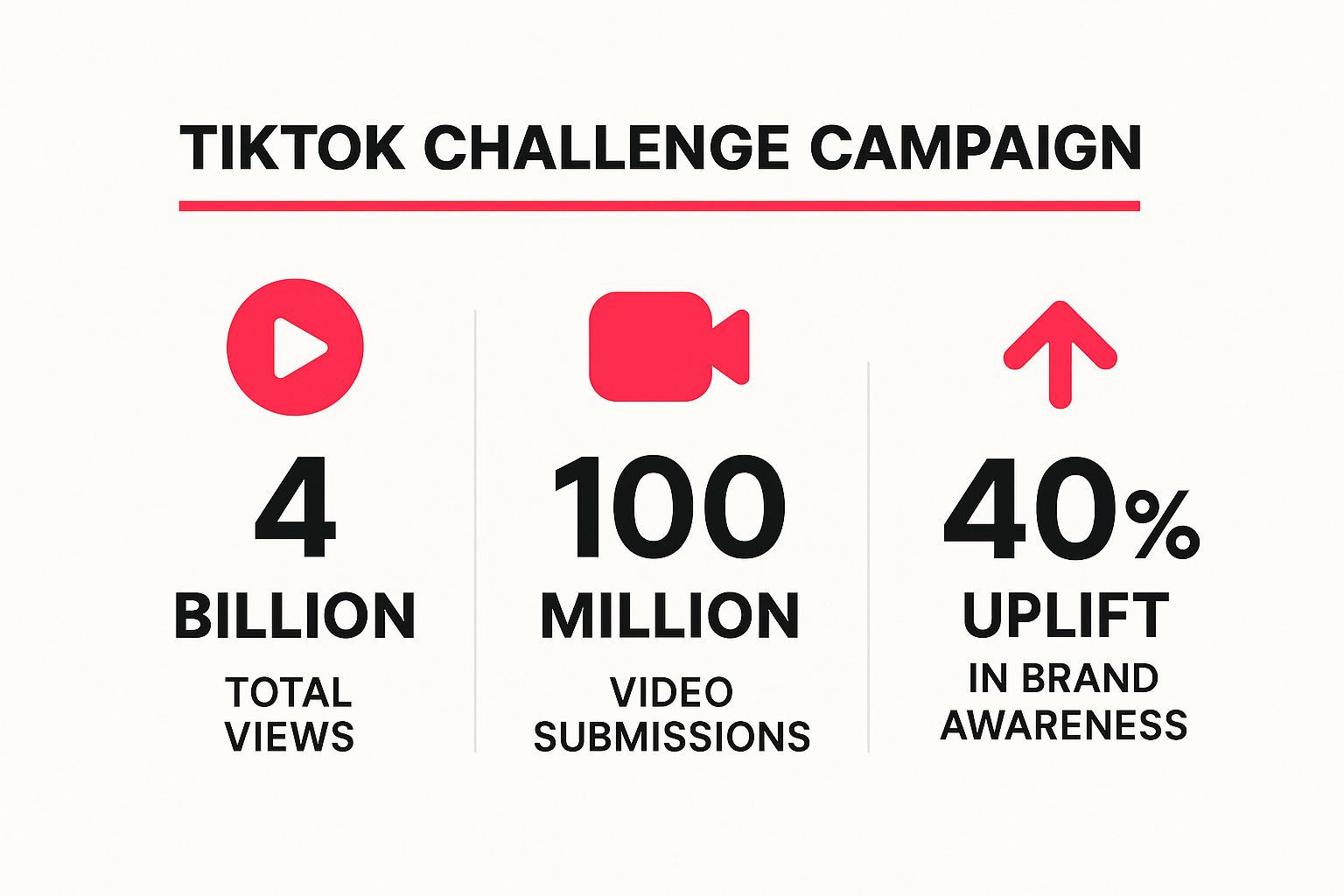
These figures highlight not just the immense reach but the profound impact on audience participation and brand perception that these campaigns can achieve.
A prime example is e.l.f. Cosmetics' #eyeslipsface campaign, which became one of TikTok's most viral branded challenges ever. The brand commissioned a custom song and created a simple challenge encouraging users to show off their eyes, lips, and face while gesturing to the lyrics. The campaign exploded, generating billions of views and millions of user-submitted videos, turning a simple makeup brand into a TikTok cultural phenomenon.
Strategic Breakdown
- Custom Audio: Creating an original, catchy song was the cornerstone. This audio became an earworm that was inseparable from the brand and the challenge, making it instantly recognizable.
- Low Barrier to Entry: The challenge was incredibly simple and inclusive. Anyone could participate, regardless of their makeup skills, which maximized the potential pool of creators.
- Creator-Led Launch: e.l.f. seeded the campaign by partnering with a few key TikTok creators to kick things off, providing initial momentum that the algorithm then amplified organically.
Key Insight: The magic of a TikTok challenge is in its replicability and creative freedom. By providing a simple framework (the audio and the hashtag), brands empower users to inject their own personality, ensuring endless, diverse content that feels authentic, not forced.
Actionable Takeaways for Your Brand
- Create an Earworm: Invest in a custom audio track that is catchy, on-brand, and easy to use. Trending sounds are good, but a unique brand sound is a powerful asset.
- Keep it Simple: Design a challenge that is easy to understand and replicate in under 15 seconds. The less friction, the more participation you'll get.
- Amplify and Engage: Don't just launch the campaign and wait. Actively engage with submissions by liking, commenting, and using TikTok's "Stitch" or "Duet" features to interact with the UGC, making participants feel seen and valued.
7. User-Generated Blog Content and Guest Posts
User-generated blog content is a powerful strategy where brands invite customers, industry experts, or community members to contribute articles and guest posts. This approach moves beyond short-form social content, leveraging the expertise and authentic stories of your audience to create in-depth, valuable resources. The result is a richer, more diverse blog that builds authority, fosters community, and provides immense value to readers, all while strengthening relationships with contributors. It transforms your blog from a monologue into a dynamic conversation.
One of the best user generated content examples in this category comes from Shopify. The Shopify blog regularly features "merchant spotlights" and success stories written by or about their actual users. These posts detail the real-world journeys of entrepreneurs who have used the platform to build their businesses, sharing specific challenges, strategies, and triumphs. This provides credible, aspirational content that resonates deeply with their target audience of aspiring and current business owners.
Strategic Breakdown
- Authenticity and Credibility: Stories from real merchants carry more weight than brand-created case studies. They offer a raw, unfiltered look at the entrepreneurial journey, which builds immense trust.
- Diverse Perspectives: By featuring businesses from various industries and stages of growth, Shopify ensures its content library is relevant to a wide spectrum of its user base, addressing a multitude of niche pain points.
- Content That Sells Itself: These stories aren't direct sales pitches. Instead, they showcase the platform's value organically through the success of its users, making for a much more compelling and persuasive form of marketing.
Key Insight: Inviting users to share their long-form stories and expertise positions your brand as a central hub for industry knowledge and community, not just a vendor of products or services.
Actionable Takeaways for Your Brand
- Establish Clear Guidelines: Create a dedicated page with detailed editorial guidelines, submission instructions, and topic suggestions. This ensures you receive high-quality, relevant content that aligns with your brand's tone and standards.
- Create a Win-Win: Offer meaningful incentives for contributors, such as a detailed author bio with backlinks, promotion across your social media channels, or even a co-hosted webinar. This recognition makes the effort worthwhile for them.
- Spotlight Customer Success: Actively seek out customers with compelling stories. Feature them in Q&A style blog posts, "how-to" guides based on their experience, or as part of a "Customer of the Month" series to generate a steady stream of authentic content.
8. Social proof Widgets and Customer Showcases
Social proof widgets and customer showcases are powerful integrations that pull user-generated content directly onto a brand’s website. These tools automatically aggregate and display customer reviews, photos, and social media posts, transforming a standard e-commerce site into a dynamic, community-driven platform. By embedding authentic customer content on product pages or in dedicated galleries, brands provide real-time social proof at the most critical points in the buyer’s journey, building trust and accelerating conversions.
Beauty brand Olaplex masterfully uses this strategy by integrating an Instagram feed of customer hair transformations directly on its site. Shoppers can see real-world results on different hair types, moving beyond polished marketing shots to see authentic proof of the product's effectiveness. This direct showcase of user-generated content examples helps potential customers visualize their own success with the product, answering key questions and overcoming purchase hesitation.
Strategic Breakdown
- Conversion-Focused Placement: Olaplex places these UGC showcases on key product and category pages, ensuring potential buyers see proof of results right when they are considering a purchase.
- Visual Authenticity: Unlike professional model photos, customer-submitted images offer a level of relatability and authenticity that is far more persuasive. This builds immediate trust and credibility.
- Automated Content Stream: Using tools like Yotpo or Foursixty, brands can automate the process of curating and displaying fresh content, ensuring the showcase is always current without constant manual effort.
Key Insight: Integrating UGC directly onto your website closes the gap between social media discovery and e-commerce conversion. It brings the power of social proof into your owned digital environment, where you can control the customer journey.
Actionable Takeaways for Your Brand
- Be Strategic with Placement: Embed photo galleries and review widgets on high-traffic product pages, category pages, and even during the checkout process to reduce cart abandonment.
- Curate for Brand Safety: Use tools with robust filtering and moderation features. This allows you to maintain brand alignment and only showcase the highest-quality, most relevant content.
- Make it Shoppable: Whenever possible, tag the specific products featured in customer photos. This creates a direct path from inspiration to purchase, turning visual UGC into an immediate sales driver.
User-Generated Content: 8 Key Example Comparison
| User-Generated Content Type | Implementation Complexity 🔄 | Resource Requirements ⚡ | Expected Outcomes 📊 | Ideal Use Cases 💡 | Key Advantages ⭐ |
|---|---|---|---|---|---|
| Instagram Hashtag Campaigns | Moderate – requires hashtag creation and monitoring | Low to Moderate – social media management | High engagement, organic reach, community building | Brand awareness, community engagement | Builds authentic user content, easy to track |
| Customer Review and Rating Systems | Moderate – integration and moderation needed | Moderate – platform management and moderation | Builds trust, increases conversions, improves SEO | E-commerce, service providers | Enhances credibility, provides valuable customer insights |
| Video Testimonials and Unboxing Content | High – requires video submissions and editing | High – content production support | High engagement, emotional connection, increased conversions | Product launches, education, emotional branding | Visual proof of benefits, strong emotional impact |
| Social Media Photo Contests | Moderate to High – contest setup, promotion, judging | Moderate – prize investment and promotion | Large volumes of visual content, increased engagement | Visual brand campaigns, community building | Generates diverse creative content, builds excitement |
| Brand Community Forums and Discussion Boards | High – ongoing moderation and platform management | High – active community and support teams | Strong brand loyalty, SEO content, reduced support load | Complex products, tech brands | Builds loyal communities, valuable product insights |
| TikTok Challenge Campaigns | Moderate – content creation and influencer seeding | Moderate – influencer partnerships, campaign management | Massive viral reach, quick brand awareness growth | Youth-targeted brands, viral marketing | High viral potential, authentic and entertaining content |
| User-Generated Blog Content and Guest Posts | Moderate – editorial oversight and content review | Moderate – editorial and outreach resources | Diverse expertise, improved SEO, thought leadership | B2B, industry-focused, content marketing | Builds relationships, diversifies content perspectives |
| Social Proof Widgets and Customer Showcases | Moderate to High – technical integration needed | Moderate – tech setup and ongoing updates | Increased conversions, real-time social validation | E-commerce sites, product pages | Automates social proof, boosts trust and conversion |
From Inspiration to Action: Launching Your UGC Strategy
The diverse array of user generated content examples we've explored demonstrates a powerful, undeniable truth in modern marketing: authentic customer voices are your most valuable asset. From the explosive virality of a well-executed TikTok challenge to the quiet, trust-building power of a detailed customer review, the strategic value of UGC is clear. It’s the engine of social proof, the foundation of community, and a direct line to increased conversions.
These successful campaigns are not happy accidents. They are the result of a deliberate strategy that places the customer at the center of the brand's story. The common thread weaving through every effective example is empowerment. Brands that win with UGC don't just ask for content; they create a framework that makes sharing easy, rewarding, and meaningful for their audience.
Synthesizing the Key Takeaways
Reflecting on the examples, from Instagram hashtag campaigns to user-submitted blog posts, several core principles emerge as critical for success:
- Clarity is Paramount: Your call to action must be simple and direct. Whether it's a specific hashtag, a contest rule, or a prompt for a review, users need to understand exactly what you want them to do without any confusion.
- Motivation Matters: Users need a reason to create content for you. This "why" can range from tangible rewards like prizes and discounts to intangible benefits like social recognition, a sense of belonging to a community, or the opportunity to be featured on your brand’s channels.
- Lower the Barrier to Entry: Make participation as frictionless as possible. Pre-filled hashtags, easy-to-use submission forms, and clear, concise instructions are essential. The more steps a user has to take, the less likely they are to participate.
- Authenticity Over Polish: The power of UGC lies in its raw, genuine nature. Encourage real stories and unpolished moments over perfectly curated, studio-quality content. This is what builds trust and resonates with potential customers.
Your Actionable Roadmap to UGC Success
Moving from inspiration to implementation is the most critical step. Don't let the scope of possibilities lead to paralysis. Instead, focus on a phased approach to integrate UGC into your marketing ecosystem.
Start by identifying the low-hanging fruit. Which type of UGC aligns best with your brand and current marketing goals? If you have a visually appealing product, a photo contest or unboxing videos might be the perfect starting point. If you have a highly engaged customer base, a dedicated community forum could unlock immense value.
Next, focus on actively encouraging participation. You can't just build the platform and expect users to come. To effectively gather user-generated content, exploring various methods for encouraging contributions is crucial. For instance, you can find strategies like these to boost participation: 8 Ways to Encourage Guests to Share Wedding Photos. While the context is specific, the principles of clear communication, incentivization, and making the process enjoyable are universally applicable to any brand campaign.
By starting small, setting measurable goals, and creating a clear brief for your desired content, you can begin to build a sustainable UGC engine. The power of authentic, customer-driven storytelling is not just for the world's biggest brands; it is ready and waiting for you to unlock.
Ready to stop waiting for UGC and start creating it on demand? JoinBrands is the AI-powered creator marketing platform designed to connect you with authentic creators who are ready to produce high-quality, engaging content for your brand. Find the perfect creators, manage campaigns, and source impactful UGC all in one place. Sign up for JoinBrands today and launch your first creator collaboration in minutes.

